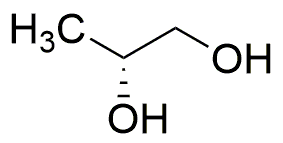(R)-(-)-1,2-Propanediol is widely utilized in research focused on
- Pharmaceutical Formulations: This compound serves as a solvent and stabilizer in various medications, enhancing the solubility and bioavailability of active ingredients.
- Cosmetic Products: It is commonly used in skincare and cosmetic formulations due to its moisturizing properties, helping to improve skin hydration and texture.
- Food Industry: As a food additive, it acts as a humectant, retaining moisture in food products, which can improve shelf life and texture.
- Antifreeze Solutions: Its low freezing point makes it an effective component in antifreeze formulations, providing protection against freezing in automotive and industrial applications.
- Biotechnology: In laboratory settings, it is used as a cryoprotectant for preserving biological samples, ensuring cell viability during freezing and thawing processes.
General Information
Properties
Safety and Regulations
Applications
(R)-(-)-1,2-Propanediol is widely utilized in research focused on
- Pharmaceutical Formulations: This compound serves as a solvent and stabilizer in various medications, enhancing the solubility and bioavailability of active ingredients.
- Cosmetic Products: It is commonly used in skincare and cosmetic formulations due to its moisturizing properties, helping to improve skin hydration and texture.
- Food Industry: As a food additive, it acts as a humectant, retaining moisture in food products, which can improve shelf life and texture.
- Antifreeze Solutions: Its low freezing point makes it an effective component in antifreeze formulations, providing protection against freezing in automotive and industrial applications.
- Biotechnology: In laboratory settings, it is used as a cryoprotectant for preserving biological samples, ensuring cell viability during freezing and thawing processes.
Documents
Safety Data Sheets (SDS)
The SDS provides comprehensive safety information on handling, storage, and disposal of the product.
Product Specification (PS)
The PS provides a comprehensive breakdown of the product’s properties, including chemical composition, physical state, purity, and storage requirements. It also details acceptable quality ranges and the product's intended applications.
Certificates of Analysis (COA)
Search for Certificates of Analysis (COA) by entering the products Lot Number. Lot and Batch Numbers can be found on a product’s label following the words ‘Lot’ or ‘Batch’.
*Catalog Number
*Lot Number
Certificates Of Origin (COO)
This COO confirms the country where the product was manufactured, and also details the materials and components used in it and whether it is derived from natural, synthetic, or other specific sources. This certificate may be required for customs, trade, and regulatory compliance.
*Catalog Number
*Lot Number
Safety Data Sheets (SDS)
The SDS provides comprehensive safety information on handling, storage, and disposal of the product.
DownloadProduct Specification (PS)
The PS provides a comprehensive breakdown of the product’s properties, including chemical composition, physical state, purity, and storage requirements. It also details acceptable quality ranges and the product's intended applications.
DownloadCertificates of Analysis (COA)
Search for Certificates of Analysis (COA) by entering the products Lot Number. Lot and Batch Numbers can be found on a product’s label following the words ‘Lot’ or ‘Batch’.
*Catalog Number
*Lot Number
Certificates Of Origin (COO)
This COO confirms the country where the product was manufactured, and also details the materials and components used in it and whether it is derived from natural, synthetic, or other specific sources. This certificate may be required for customs, trade, and regulatory compliance.


